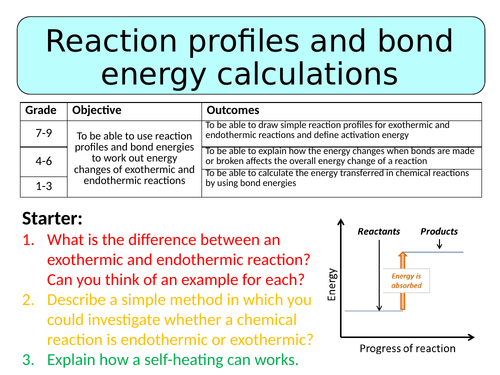
This lesson is designed for the NEW AQA Trilogy Chemistry GCSE, particularly the ‘Chemical changes, electrolysis and energy changes’ SoW.
For more lessons designed to meet specification points for the NEW AQA Trilogy specifications for Biology, Chemistry and Physics please see my shop: https://www.tes.com/teaching-resources/shop/SWiftScience
The first task is a recap on the differences between endothermic and exothermic reactions, students will need to complete a fill-in-the blank task which can then be self-assessed using the answers provided.
Next, students are introduced to reaction profiles with a diagram to demonstrate what is happening during an exothermic chemical reaction. Students will then be asked to use mini-whiteboards to draw a reaction profile for an endothermic reaction, they can check their ideas using the answer provided in the PowerPoint. The next slide shows the reaction profiles for both an endothermic and exothermic reaction, as well as an explanation of the energy changes which take place during these types of reaction. Pupils can take notes from this slide, including sketching a diagram of the two reaction profiles.
The next task is for pupils to complete is a progress check to assess their understanding of what they have learned so far, once complete pupils can self-assess or peer-assess their work using the answers provided.
Next, pupils will watch a video on activation energy, they will need to answer a set of questions using the information provided in the video. Pupils can self-assess their work using the mark scheme provided in the PowerPoint.
The next part of the lesson focuses on bond breaking/making and bond energies. Firstly, students are shown (using a diagram to demonstrate) what happens, in terms of energy changes, when bonds are broken or when bonds form during a chemical reaction. Students can then summarise what they have learnt so far by completing a fill-in-the-blank task, this task can be self-assessed using the mark scheme provided.
Lastly, students are introduced to bond energies and are shown how to calculate the energy change for a chemical reaction using a worked example. Students will then need to complete a worksheet on bond energy calculations. The mark scheme for the worksheet is included in the PowerPoint for pupils to self-assess or peer-assess their work.
The plenary task requires pupils to identify a WWW and EBI from the lesson, listing what went well/what they have fully understood and what they could do better next time.
All resources are included at the end of the presentation. Thanks for looking, if you have any questions please let me know in the comments section and any feedback would be appreciated :)
Get this resource as part of a bundle and save up to 50%
A bundle is a package of resources grouped together to teach a particular topic, or a series of lessons, in one place.
Something went wrong, please try again later.
excellent
Report this resourceto let us know if it violates our terms and conditions.
Our customer service team will review your report and will be in touch.
